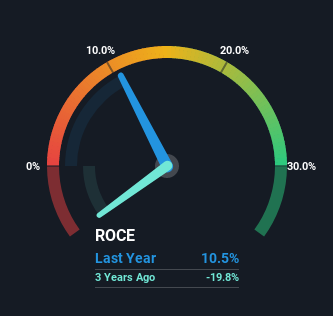[ad_1]
Finding a business that has the potential to grow substantially is not easy, but it is possible if we look at a few key financial metrics. Typically, we’ll want to notice a trend of growing return on capital employed (ROCE) and alongside that, an expanding base of capital employed. Ultimately, this demonstrates that it’s a business that is reinvesting profits at increasing rates of return. In light of that, when we looked at Bialetti Industrie (BIT:BIA) and its ROCE trend, we weren’t exactly thrilled.
Return On Capital Employed (ROCE): What Is It?
For those that aren’t sure what ROCE is, it measures the amount of pre-tax profits a company can generate from the capital employed in its business. Analysts use this formula to calculate it for Bialetti Industrie:
Return on Capital Employed = Earnings Before Interest and Tax (EBIT) ÷ (Total Assets – Current Liabilities)
0.10 = €11m ÷ (€156m – €55m) (Based on the trailing twelve months to June 2022).
Therefore, Bialetti Industrie has an ROCE of 10%. That’s a relatively normal return on capital, and it’s around the 11% generated by the Consumer Durables industry.
See our latest analysis for Bialetti Industrie

While the past is not representative of the future, it can be helpful to know how a company has performed historically, which is why we have this chart above. If you’d like to look at how Bialetti Industrie has performed in the past in other metrics, you can view this free graph of past earnings, revenue and cash flow.
So How Is Bialetti Industrie’s ROCE Trending?
In terms of Bialetti Industrie’s historical ROCE movements, the trend isn’t fantastic. To be more specific, ROCE has fallen from 43% over the last five years. Meanwhile, the business is utilizing more capital but this hasn’t moved the needle much in terms of sales in the past 12 months, so this could reflect longer term investments. It’s worth keeping an eye on the company’s earnings from here on to see if these investments do end up contributing to the bottom line.
On a side note, Bialetti Industrie has done well to pay down its current liabilities to 35% of total assets. That could partly explain why the ROCE has dropped. What’s more, this can reduce some aspects of risk to the business because now the company’s suppliers or short-term creditors are funding less of its operations. Since the business is basically funding more of its operations with it’s own money, you could argue this has made the business less efficient at generating ROCE.
The Key Takeaway
Bringing it all together, while we’re somewhat encouraged by Bialetti Industrie’s reinvestment in its own business, we’re aware that returns are shrinking. Since the stock has declined 37% over the last five years, investors may not be too optimistic on this trend improving either. All in all, the inherent trends aren’t typical of multi-baggers, so if that’s what you’re after, we think you might have more luck elsewhere.
If you want to know some of the risks facing Bialetti Industrie we’ve found 4 warning signs (3 don’t sit too well with us!) that you should be aware of before investing here.
While Bialetti Industrie may not currently earn the highest returns, we’ve compiled a list of companies that currently earn more than 25% return on equity. Check out this free list here.
Valuation is complex, but we’re helping make it simple.
Find out whether Bialetti Industrie is potentially over or undervalued by checking out our comprehensive analysis, which includes fair value estimates, risks and warnings, dividends, insider transactions and financial health.
View the Free Analysis
Have feedback on this article? Concerned about the content? Get in touch with us directly. Alternatively, email editorial-team (at) simplywallst.com.
This article by Simply Wall St is general in nature. We provide commentary based on historical data and analyst forecasts only using an unbiased methodology and our articles are not intended to be financial advice. It does not constitute a recommendation to buy or sell any stock, and does not take account of your objectives, or your financial situation. We aim to bring you long-term focused analysis driven by fundamental data. Note that our analysis may not factor in the latest price-sensitive company announcements or qualitative material. Simply Wall St has no position in any stocks mentioned.
[ad_2]
Source link








